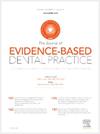EFFECTIVENESS OF CLEAR ORTHODONTIC ALIGNERS IN CORRECTING MALOCCLUSIONS: A SYSTEMATIC REVIEW AND META-ANALYSIS
IF 4
4区 医学
Q1 DENTISTRY, ORAL SURGERY & MEDICINE
引用次数: 0
Abstract
Objective
The purpose of this research was to assess the effectiveness of clear aligners in treating various types of malocclusions when compared to fixed orthodontic appliances.
Methods and Quality
The following databases were searched: EMBASE (Ovid), Medline (Ovid), the Cochrane Library, Latin America and the Caribbean Literature on Health Sciences (Lilacs), Web of Science and EBMR review until October 2024. Additionally, Google scholar, PubMed were also searched for completion for including all relevant articles. No restrictions were placed on language or publication date, and only randomized controlled trials (RCTs) were included in this review. Evaluation of the potential for bias in randomized controlled trials (RCTs) was carried out with the use of the revised Cochrane Risk of Bias instrument (ROB tool 2). The primary outcome was the treatment accuracy of clear aligners vs fixed appliances and included orthodontic tooth movement in terms of anteroposterior discrepancy, transverse discrepancy, vertical discrepancy and overjet. The secondary outcomes included the effectiveness of treatment, such as duration of treatment, periodontal health, root resorption and patient satisfaction. Available data was meta-synthesized using Review Manager 5.4.
Results
About 21 RCT studies were selected from a total of 600 records and involved 970 participants. All 21 studies included a comparison of the effectiveness of clear aligners vs fixed appliances. About 3 of the studies were assessed to be at high risk of bias, whilst 14 of the studies were assessed to be at unclear risk of bias, and only 1 study was found to be at low risk of bias. Based on the primary outcome, there was no significant difference in the ABO objective grading scores, Little Irregularity Index and PAR scores between the fixed appliances and clear aligner treatments. Meta-analysis was only possible for secondary outcomes. The scores for plaque index (MD = -0.76, 95% CI, -1.14 to - 0.38, P = .00001), gingival index (MD = -0.61, 95% CI, -0.78 to - 0.44, P = .00001) and bleeding index (MD = -0.71, 95% CI, -0.92 to - 0.49, P < .0001) were significantly lower in clear aligners when compared to the fixed appliances. The patients quality of life at 6 months was significantly better for clear aligners compared with fixed appliances (MD = -4.37, 95% CI, -6.93 to -1.80, P < .0001). Clear aligners also appeared to have a better outcome for chairside time, pain and root resorption.
Conclusion
The overall quality of evidence from the included studies was low. Both clear aligners and fixed appliances worked well in treating simple malocclusions treated on a nonextraction basis. There was no significant difference in the ABO Objective Grading System, Little Irregularity index and PAR scores between the clear aligner and fixed appliance groups. There was low quality evidence available in favor of clear aligners for periodontal health and moderate quality evidence in favor of clear aligners for quality of life. More high-quality studies evaluating clear aligner treatment for treating complex malocclusions are required.
正畸矫正器在矫正错牙合中的有效性:一项系统回顾和荟萃分析
目的评价透明矫正器与固定矫治器在治疗不同类型错牙合中的效果。方法和质量检索以下数据库:EMBASE (Ovid)、Medline (Ovid)、Cochrane图书馆、Latin America and Caribbean Literature on Health Sciences (Lilacs)、Web of Science和EBMR review,检索截止至2024年10月。此外,谷歌scholar, PubMed也被检索以完成包括所有相关文章。本综述对语言和发表日期没有限制,仅纳入随机对照试验(rct)。使用改进的Cochrane偏倚风险评估工具(ROB工具2)对随机对照试验(RCTs)的潜在偏倚进行评估。主要结果是透明矫正器与固定矫治器的治疗准确性,包括正畸牙齿移动的前后差异、横向差异、垂直差异和覆盖。次要结果包括治疗效果,如治疗持续时间、牙周健康、牙根吸收和患者满意度。使用Review Manager 5.4对可用数据进行元合成。结果从600份记录中选择了21项RCT研究,涉及970名受试者。所有21项研究都比较了透明矫正器与固定矫治器的有效性。约有3项研究被评估为高偏倚风险,14项研究被评估为不明确的偏倚风险,只有1项研究被发现为低偏倚风险。基于主要结局,固定矫治器和清除矫治器治疗的ABO客观分级评分、小不规则指数和PAR评分无显著差异。荟萃分析仅适用于次要结果。斑块指数(MD = -0.76,95% CI, -1.14 ~ - 0.38, P = 0.00001)、牙龈指数(MD = -0.61,95% CI, -0.78 ~ - 0.44, P = 0.00001)和出血指数(MD = -0.71,95% CI, -0.92 ~ - 0.49, P <;.0001)与固定矫治器相比,透明矫治器明显更低。与固定矫治器相比,使用透明矫正器患者6个月的生活质量明显更好(MD = -4.37,95% CI, -6.93 ~ -1.80, P <;。)。透明矫正器在椅侧时间、疼痛和牙根吸收方面也有更好的效果。结论纳入研究的证据质量总体较低。在不拔牙的基础上,清除矫正器和固定矫治器都能很好地治疗单纯性错颌。清除矫正器组与固定矫治器组在ABO客观评分系统、小不规则指数和PAR评分上无显著差异。有低质量的证据支持透明矫正器对牙周健康的改善,中等质量的证据支持透明矫正器对生活质量的改善。需要更多高质量的研究来评估清晰矫正器治疗复杂错颌的效果。
本文章由计算机程序翻译,如有差异,请以英文原文为准。
求助全文
约1分钟内获得全文
求助全文
来源期刊

Journal of Evidence-Based Dental Practice
DENTISTRY, ORAL SURGERY & MEDICINE-
CiteScore
6.00
自引率
16.70%
发文量
105
审稿时长
28 days
期刊介绍:
The Journal of Evidence-Based Dental Practice presents timely original articles, as well as reviews of articles on the results and outcomes of clinical procedures and treatment. The Journal advocates the use or rejection of a procedure based on solid, clinical evidence found in literature. The Journal''s dynamic operating principles are explicitness in process and objectives, publication of the highest-quality reviews and original articles, and an emphasis on objectivity.
 求助内容:
求助内容: 应助结果提醒方式:
应助结果提醒方式:


